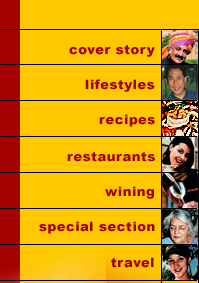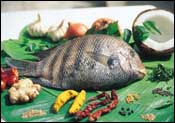


 Karimeen, A Fish Out Of The Backwaters!
Karimeen, A Fish Out Of The Backwaters!Like the hilsa in Calcutta and the ladyfish in Mangalore, the karimeen of Cochin�s backwaters is a very special fish. It�s inclusion on any menu is cause for celebration, says Jose Solomon |
|
IF West Bengal has its hilsa, Goa its kingfish, and Karnataka its ladyfish, then Kerala has the karimeen, a plump silver-black fish whose very presence on any dinner table is cause for celebration. Not just in the small thatched homes of devout Hindus, Malabari Muslims, Syrian Christians and Orthodox Jews in Kerala, but also in restaurants elsewhere in the country that specialise in seafood, and South Indian seafood at that. Wherever he is, if the Keralite has a choice between karimeen and any other exotic fish of the world, his finger will point at the karimeen. Karimeen is a delicacy in Kerala, and it is a fish that is not seasonal, meaning, it is available all year round. It is not a sea (salt water) fish, nor a river (sweet water) fish, because karimeen is found exclusively in the backwaters of Kerala. What does that make it? A bit of both! Karimeen is plucked out of the backwaters of Cochin by fishermen with nets in tiny catamarans, it is packed in ice, and flown down to little South Indian eateries in Bombay run by enterprising restaurateurs. In these, it is proudly introduced as the catch of the day, and offered to discerning patrons in a mildly spicy red curry, tandoored or pan-fried. If the karimeen is being had as a curry, it is best had with the Kerala aapam or neer dosa. Or with rice. No meal is complete without rice, especially the parboiled variety, a rice which is not the usual white, milled kind, but which has been parboiled and dried in courtyards and fields. The tandoori karimeen and the karimeen fry, are best eaten by themselves. They go well with a gin and lime, too. In taste, the karimeen is described by Keralites as being better than even the pomfret. And that is saying a lot, because the pomfret is king of the Indian seas and a fish that happily lends itself to a variety of recipes. Kerala's backwaters are rich with karimeen, but still, the fish is extremely expensive. A kilo costs around Rs. 250, and you will get three fish in a kilo. One is enough for anybody's meal. And the best way to have the karimeen is in a curry, though if you are Mangalorean, you might want it in a gassi. The difference between the curry and gassi is the coconut milk in the gassi. It is the thicker gravy of the two. Though the Kerala curry is spicier, the little black Cochin peppercorns add their own bite to the curry. Order a plate of aapams to go with your meal. The aapams soak in the curry and you may pick the flesh of the karimeen of the bones and have it by the chunkful.
|

Home Page